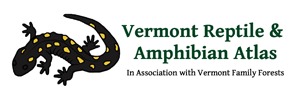Herp Update: Morgan Road education and amphibian migration — April 13, 2024
Folks, each spring the Otter Creek Audubon Society (OSAS) and the Salisbury Conservation Commission host two public educational events on Morgan Road in Salisbury, to introduce people to the wonderful phenomenon of amphibian spring migration. This year our first public event was held five weeks ago on March 6. That was unusually early. After March 6, winter and snow returned twice, interrupted by warmer weather. Then spring, along with amphibian-migration conditions (warm and wet nights) returned on Tuesday, April 9th, over a month later. Between March 6 and April 9th, there were a few late-night opportunities, or more marginal conditions during which some amphibians could move. So, when the timing and weather conditions again were appropriate for a public amphibian migration event on Morgan Road, I was a bit concerned about what amphibians would still be moving.
On arrival at Morgan Road a large choruses of Wood Frogs and Spring Peepers could be heard calling from the Leicester Swamp. So, most of those two species had already moved. In addition, if Spring Peepers had moved, most of the Spotted Salamanders must have already moved as well. Here at the Vermont Reptile and Amphibian Atlas, records had been pouring in of amphibians moving on Tuesday, Wednesday, and Thursday nights. Uh oh, after inviting everyone (and Channel 3 News) out to see amphibian migration, would we have any amphibians left migrating?
When Ron Payne and Melissa Green from OCAS arrived, guests’ cars were already backed up a quarter mile from our crossing area. By the time, my wife Kris, Chris & Preston Turner, Sue Staats, Barb Karle, and John Metcalfe were in place with their clipboards, we had over fifty guests, two film cameras, and very few amphibians on the move. My educational collection of amphibians gathered was very thin. Gradually over the next hour, amphibian migration slowly picked up. Most Wood Frogs, Spring Peepers, Spotted Salamanders, and the larger Blue-spotted Salamanders had indeed already migrated into the forested Leicester River Swamp. Still, there were other species and other age classes that had not.
Over the next two hours and 20 minutes, 74 participants of all ages, tallied 575 amphibians of nine species. This was a very respectable migration. Eastern Red-backed Salamanders made up the bulk of the migrants with a total of 408 moving through our crossing area during our visit. Next in abundance were the 63 Blue-spotted Salamanders. Most of these were quite young and small, with only a few adults still migrating. Neither the Eastern Red-backed Salamanders nor the small Blue-spotted Salamanders are moving into the swamp to breeding ponds. The Eastern Red-backeds don’t lay their eggs in the water and the young Blue-spotteds were too young to breed. They are simply moving from their wintering locations into woods with more moisture in which to feed during the summer.
Next in abundance were the 57 Four-toed Salamanders. These are an unusual species not found at most crossing areas, so we are fortunate to be able to see them in Salisbury. They are also found at the North Street Crossing in Monkton. If you don’t include reports of Four-toed Salamanders from these two locations, we found more Four-toed Salamanders last night in Salisbury (57) than the total of Four-toed Salamanders (30) reported the entire year of 2023 from all other sites in VT.
Moving down the line in order of abundance, were the 25 Wood Frogs, 10 Spring Peepers, 6 Eastern Newts, 3 Spotted Salamanders, 2 Gray Treefrogs, and a single American Toad. The Gray Treefrogs and American Toads usually move later in the spring when the night-time temperatures are even warmer. The few that we saw are just the leading edge of their activity.

